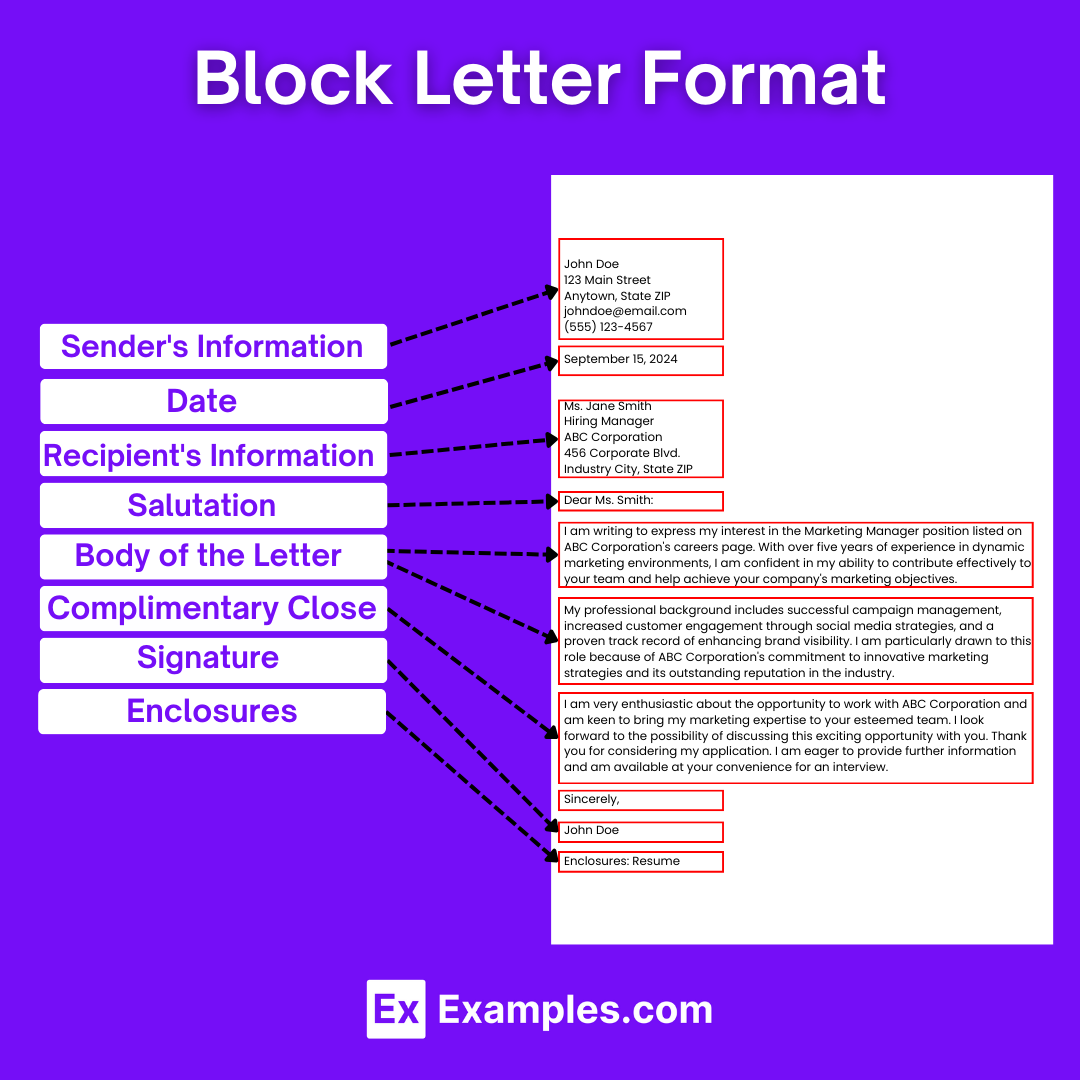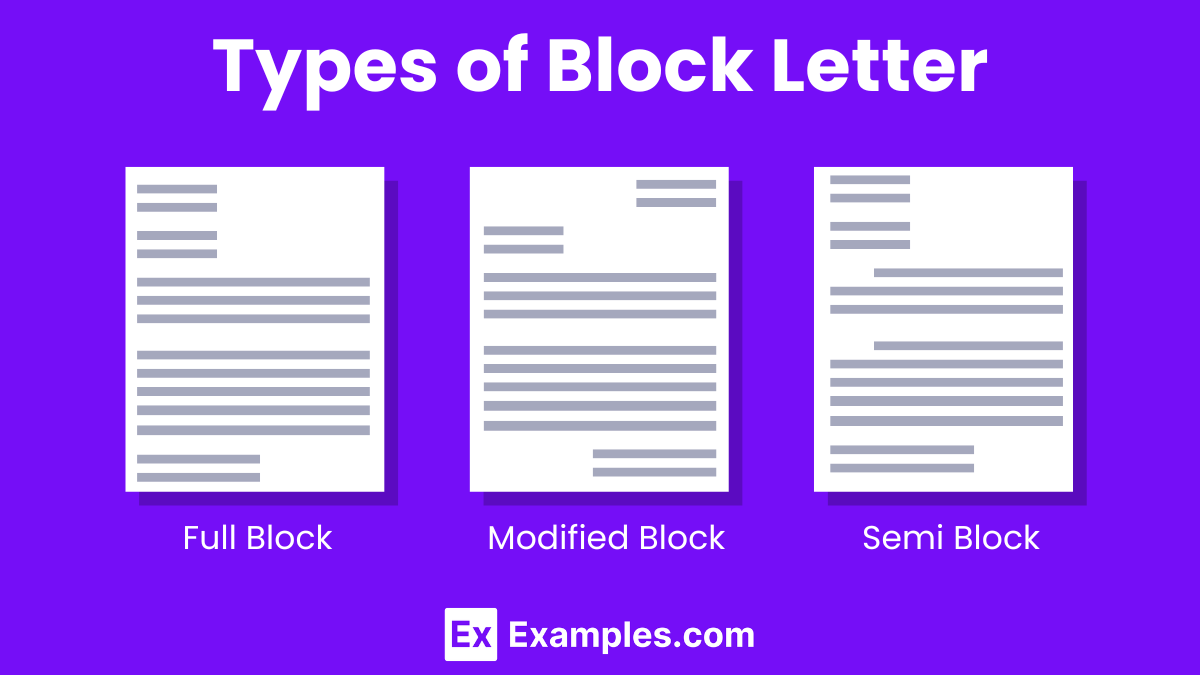19+ Block Letter Examples to Download
Whether you’re applying for a job, sending a business letter, or writing a cover letter, the way you present your message is just as important as the message itself. That’s why it’s crucial to pay attention to the format of your writing. One popular format that can help you achieve a professional and polished look is Block Letter Format.
What is Block Letter?
A block letter refers to a style of writing or formatting used in formal business correspondence. In this format, all text is aligned to the left margin, creating a “block” of text that’s easy to read. Block letter format typically includes single-spaced lines with a double space between paragraphs, and it does not indent paragraphs. This style is widely used because it presents a neat, organized appearance, making it a standard for professional communications. It includes elements such as the sender’s address, date, recipient’s address, salutation, body of the letter, closing, and the sender’s signature
Block Letter Format
[Your Address]
[City, State, Zip Code]
[Email Address]
[Phone Number]
[Date][Recipient’s Name]
[Recipient’s Title]
[Company’s Name]
[Company’s Address]
[City, State, Zip Code]Dear [Recipient’s Name]:
[Body of the Letter]
Sincerely,
[Your Signature (if sending a hard copy)]
[Your Typed Name]Enclosure(s): [List of enclosed documents, if any]
Types of Block Letter
Full Block Style
The Full Block Style is the most formal and commonly used format in business and official correspondence. In this layout, every element of the letter, including the sender’s address, date, recipient’s address, salutation, body, closing, and signature, aligns to the left margin. There are no indented lines, creating a uniform and clean appearance. This style emphasizes professionalism and simplicity, making it a popular choice for formal communications.
Modified Block Style
The Modified Block Style offers a blend of formality and modern design. It distinguishes itself from the full block style by positioning the sender’s address, date, complimentary close, and signature towards the center or right side of the page, while the rest of the content aligns to the left. This style maintains a professional look while introducing an element of visual interest, making it suitable for business letters that seek a balance between tradition and contemporary aesthetics.
Semi-Block Style
The Semi-Block Style, also known as the Indented Style, combines elements of the full block and modified block styles with a traditional twist. While it aligns the sender’s address, date, and closing to the right, similar to the modified block style, each paragraph in the letter’s body starts with an indentation. This format adds a degree of formality and structure to the document, making it appropriate for business letters that require a more traditional approach while still adhering to professional standards.
How to write in Block Letter Format
Effective communication is a key aspect of professional relationships, whether in the workplace or beyond. By following these simple steps, you can create a professional and effective letter using the Block Letter Format.
- Choose a Clear and Concise Font: Choose a clear and easy-to-read font, such as Arial or Times New Roman, with a font size of 12 points.
- Align Text to the Left Margin: Align all text to the left margin, without using any indentation for each paragraph.
- Use Single Spacing between Lines and Double Spacing between Paragraphs: Use single spacing between lines and double spacing between paragraphs to ensure the letter is easy to read.
- Include Your Contact Information: At the top of the letter, include your contact information, such as your name, address, phone number, and email, aligned to the right margin.
- Add the Date: Skip one line and include the date.
- Include the Recipient’s Contact Information: Skip another line and add the recipient’s contact information, including their name, title, organization, and address, aligned to the left margin.
- Start with a Formal Salutation: Start the letter with a formal salutation, such as “Dear [Recipient’s Name],”.
- Use Clear and Concise Language in the Body of the Letter: In the body of the letter, use clear and concise language to convey your message. Break up the text into short paragraphs to make it easy to read.
- End with a Formal Closing: End the letter with a formal closing, such as “Sincerely” or “Best regards,” followed by your name and signature.
Difference between Formal Letter & Block Letter
This section delves into the nuances distinguishing formal letter from block letters, emphasizing their respective uses, structural differences, and formatting norms. Through a detailed comparative table, we aim to provide a clear understanding of how formal letters vary from the block letter format, catering to different communication needs.
| Feature | Formal Letter | Block Letter |
|---|---|---|
| Definition | A type of letter used for official or serious occasions. | A style of writing or formatting letters, often used in formal contexts. |
| Purpose | To convey official requests, complaints, or to provide information. | To ensure clarity and legibility, regardless of the letter’s content. |
| Formatting | May follow various formats including block, modified block, etc. | Characterized by a specific alignment; all text is justified to the left margin. |
| Tone | Usually formal and professional. | Can be formal or informal, depending on the context of the letter. |
| Usage | Used in business, academic, and other formal settings. | Used in both formal and informal settings; preferred for its readability. |
| Examples | Business proposals, academic applications, official complaints. | Business letters, personal letters, educational materials. |
| Distinct Features | Formal language, specific conventions like salutation and closing. | Uniform lettering style and spacing, often employing a full block format. |
9+ Block Letter examples
1. Business Letter Block Format
2. Thank You Letter Block Format
3. Fellowship Block Letter Format
4. Cover Letter Format Block Style
5. Employability Letter Block Format
6. Volunteer Application Block Letter Format
7. Semi Block Letter Format
8. Sample Letter in Block Style Format
9. Full Block Style Letter Format
10. Standard Block Letter Format
11. Indented Block Letter Format
12. Block Letter Assignment Format
13. Modified Block Format Letter
14. Formal Block Letter Format
15. Final Reflection Block Style Letter
16. Simple Block Letter Format
17. Scholarship Committee Block Letter Format

18. Basketball Coach Block Format Letter
19. Company Block Letter Format
20. Assistant Professor Block Letter Format
Uses of Block Letters in Professional Settings
Block letters, characterized by their clear and legible form, play a crucial role in various professional settings. This standardized writing style ensures that communication is straightforward and universally understandable, making it ideal for a wide range of applications. Here are some key uses of block letters in professional environments:
- Business Correspondence: In business letters, memos, and emails, block letters contribute to the clarity and formality of the communication. They are particularly useful in ensuring that important information is easily readable, reducing the chance of misinterpretation.
- Signage and Wayfinding: Block letters are extensively used in signage due to their high legibility at a distance. This includes office directories, safety signs, and informational signage, helping individuals navigate spaces efficiently and safely.
- Legal Documents: The use of block letters in legal documents such as contracts, agreements, and official forms minimizes ambiguity. This clarity is essential in legal contexts, where precise language and readability are paramount.
- Branding and Logo Design: In branding, block letters offer a clean, impactful aesthetic. They are often used in logos, business cards, and marketing materials to convey strength, reliability, and professionalism.
- Technical Manuals and Reports: Technical documentation, such as manuals, reports, and specifications, benefits from the use of block letters. This style facilitates the comprehension of complex information, making it accessible to a broader audience.
- Labeling and Packaging: Product labels and packaging often employ block letters to ensure that essential information, such as ingredients, usage instructions, and safety warnings, is easily legible.
- Online Content Creation: For digital content, including websites, blogs, and social media posts, block letters enhance readability on various devices. This is crucial for engaging readers and conveying messages effectively in the digital age.
- Educational Materials: In educational settings, block letters are used in textbooks, study guides, and visual aids to support learning. Their clarity helps students of all ages focus on the content without the distraction of deciphering handwriting.
- Professional Presentations: Block letters are favored in PowerPoint presentations and informational handouts to ensure key points are readable, even from a distance. This enhances communication effectiveness in meetings, conferences, and workshops.
- Record Keeping and Filing Systems: In administrative tasks, block letters improve the organization and retrieval of documents. This is especially useful in filing systems, where clear labeling helps in maintaining efficient records management.
FAQs
How to Do Block Letters for Kids
Teaching kids to write block letters involves starting with simple shapes, like squares and circles, to form letters. Use lined paper for guidance, showing them how to construct letters piece by piece. Practice regularly with large, clear examples and encourage creativity.
How to Do the Letter A in Block Letters
To draw the letter ‘A’ in block letters, start with two diagonal lines that meet at a point at the top. Add a horizontal line across the middle to complete the structure. Ensure the lines are straight and of equal thickness for uniformity.
What Is Block Letter Layout?
The block letter layout is a writing format where all text is aligned to the left margin, creating a clean and uniform appearance. This layout includes single spaces between lines and a double space between paragraphs, commonly used in formal business correspondence.
Why is Block Letter Format used?
Block Letter Format is used because it is clear and easy to read, and it gives a professional appearance to business letters.
Is Block Letter Format the only format for business letters?
No, there are other formats for business letters, such as Modified Block Format and Semi-Block Format. However, Block Letter Format is the most commonly used format.
Are there any variations to the Block Letter Format?
Yes, there can be slight variations to the Block Letter Format depending on the specific requirements of the letter or the preferences of the writer. However, the basic elements of the format, such as the alignment and spacing, should remain consistent from the title page, introduction paragraph, and down to the conclusion paragraph.
In conclusion, Block Letter Format is a widely used format for business letters that gives a professional and polished appearance to the letter. By following the steps outlined in this format, writers can ensure that their letters are easy to read and convey a clear and concise message. Whether for job applications, introductions, or recommendations, Block Letter Format is a reliable and effective choice for formal business letter correspondence.
19+ Block Letter Examples to Download
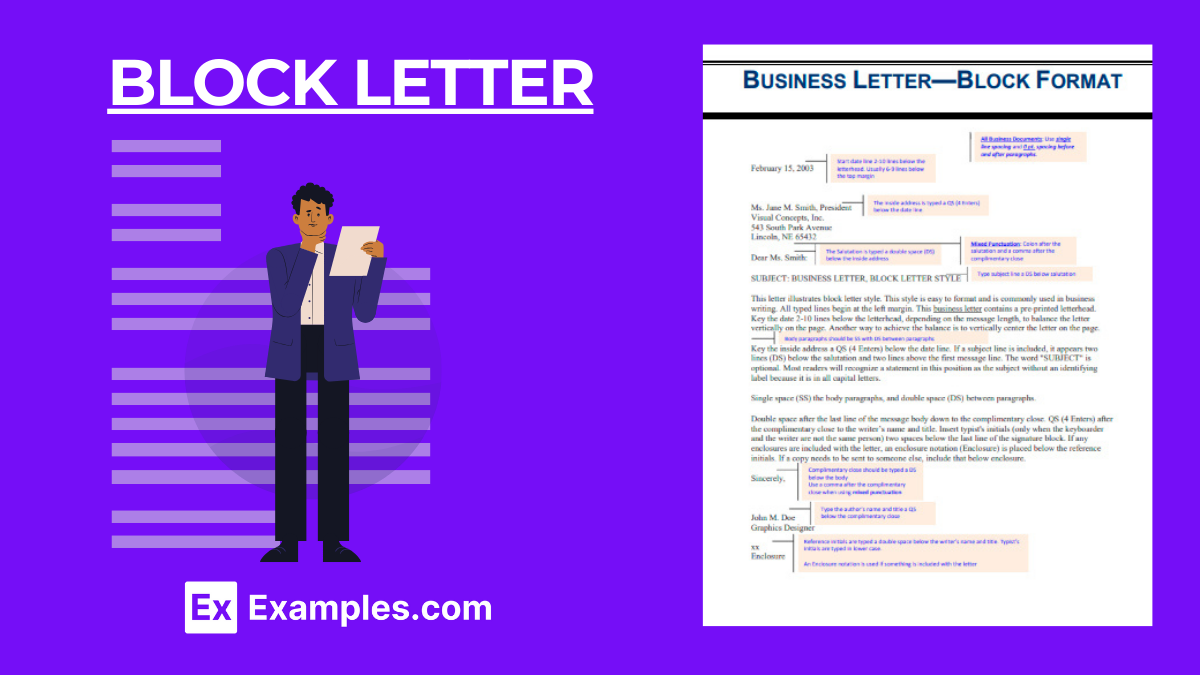
Whether you’re applying for a job, sending a business letter, or writing a cover letter, the way you present your message is just as important as the message itself. That’s why it’s crucial to pay attention to the format of your writing. One popular format that can help you achieve a professional and polished look is Block Letter Format.
What is Block Letter?
A block letter refers to a style of writing or formatting used in formal business correspondence. In this format, all text is aligned to the left margin, creating a “block” of text that’s easy to read. Block letter format typically includes single-spaced lines with a double space between paragraphs, and it does not indent paragraphs. This style is widely used because it presents a neat, organized appearance, making it a standard for professional communications. It includes elements such as the sender’s address, date, recipient’s address, salutation, body of the letter, closing, and the sender’s signature
Block Letter Format
[Your Address]
[City, State, Zip Code]
[Email Address]
[Phone Number]
[Date][Recipient’s Name]
[Recipient’s Title]
[Company’s Name]
[Company’s Address]
[City, State, Zip Code]Dear [Recipient’s Name]:
[Body of the Letter]
Sincerely,
[Your Signature (if sending a hard copy)]
[Your Typed Name]Enclosure(s): [List of enclosed documents, if any]
Types of Block Letter
Full Block Style
The Full Block Style is the most formal and commonly used format in business and official correspondence. In this layout, every element of the letter, including the sender’s address, date, recipient’s address, salutation, body, closing, and signature, aligns to the left margin. There are no indented lines, creating a uniform and clean appearance. This style emphasizes professionalism and simplicity, making it a popular choice for formal communications.
Modified Block Style
The Modified Block Style offers a blend of formality and modern design. It distinguishes itself from the full block style by positioning the sender’s address, date, complimentary close, and signature towards the center or right side of the page, while the rest of the content aligns to the left. This style maintains a professional look while introducing an element of visual interest, making it suitable for business letters that seek a balance between tradition and contemporary aesthetics.
Semi-Block Style
The Semi-Block Style, also known as the Indented Style, combines elements of the full block and modified block styles with a traditional twist. While it aligns the sender’s address, date, and closing to the right, similar to the modified block style, each paragraph in the letter’s body starts with an indentation. This format adds a degree of formality and structure to the document, making it appropriate for business letters that require a more traditional approach while still adhering to professional standards.
How to write in Block Letter Format
Effective communication is a key aspect of professional relationships, whether in the workplace or beyond. By following these simple steps, you can create a professional and effective letter using the Block Letter Format.
Choose a Clear and Concise Font: Choose a clear and easy-to-read font, such as Arial or Times New Roman, with a font size of 12 points.
Align Text to the Left Margin: Align all text to the left margin, without using any indentation for each paragraph.
Use Single Spacing between Lines and Double Spacing between Paragraphs: Use single spacing between lines and double spacing between paragraphs to ensure the letter is easy to read.
Include Your Contact Information: At the top of the letter, include your contact information, such as your name, address, phone number, and email, aligned to the right margin.
Add the Date: Skip one line and include the date.
Include the Recipient’s Contact Information: Skip another line and add the recipient’s contact information, including their name, title, organization, and address, aligned to the left margin.
Start with a Formal Salutation: Start the letter with a formal salutation, such as “Dear [Recipient’s Name],”.
Use Clear and Concise Language in the Body of the Letter: In the body of the letter, use clear and concise language to convey your message. Break up the text into short paragraphs to make it easy to read.
End with a Formal Closing: End the letter with a formal closing, such as “Sincerely” or “Best regards,” followed by your name and signature.
Difference between Formal Letter & Block Letter
This section delves into the nuances distinguishing formal letter from block letters, emphasizing their respective uses, structural differences, and formatting norms. Through a detailed comparative table, we aim to provide a clear understanding of how formal letters vary from the block letter format, catering to different communication needs.
Feature | Formal Letter | Block Letter |
|---|---|---|
Definition | A type of letter used for official or serious occasions. | A style of writing or formatting letters, often used in formal contexts. |
Purpose | To convey official requests, complaints, or to provide information. | To ensure clarity and legibility, regardless of the letter’s content. |
Formatting | May follow various formats including block, modified block, etc. | Characterized by a specific alignment; all text is justified to the left margin. |
Tone | Usually formal and professional. | Can be formal or informal, depending on the context of the letter. |
Usage | Used in business, academic, and other formal settings. | Used in both formal and informal settings; preferred for its readability. |
Examples | Business proposals, academic applications, official complaints. | Business letters, personal letters, educational materials. |
Distinct Features | Formal language, specific conventions like salutation and closing. | Uniform lettering style and spacing, often employing a full block format. |
9+ Block Letter examples
1. Business Letter Block Format
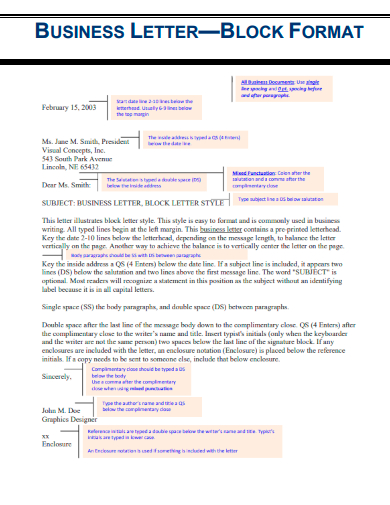
ic.arc.losrios.edu
2. Thank You Letter Block Format
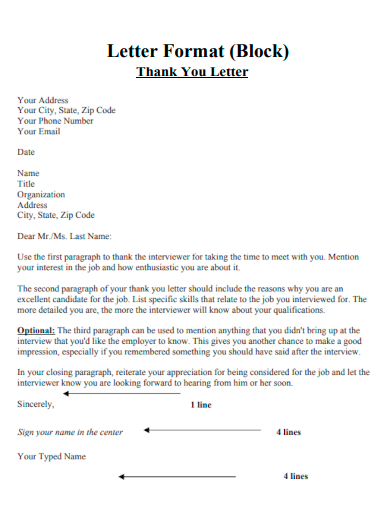
schoolwires.net
3. Fellowship Block Letter Format
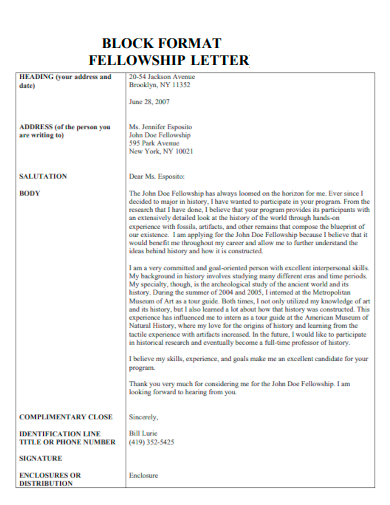
hunter.cuny.edu
4. Cover Letter Format Block Style
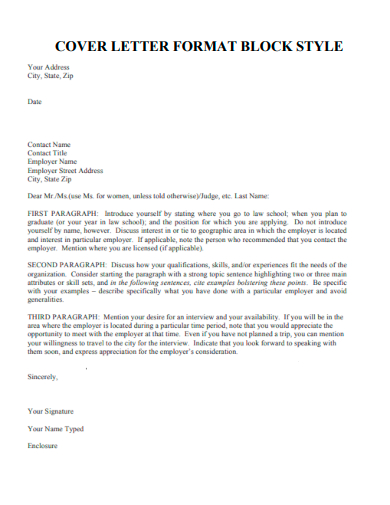
law.richmond.edu
5. Employability Letter Block Format
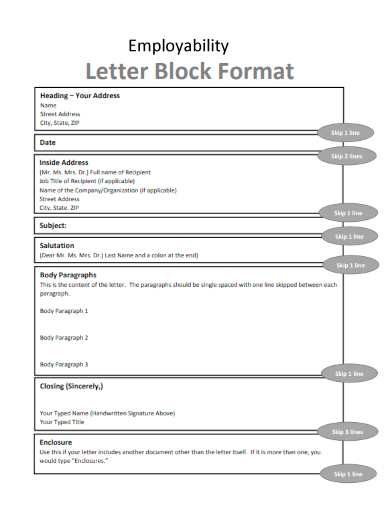
realityworks.com
6. Volunteer Application Block Letter Format
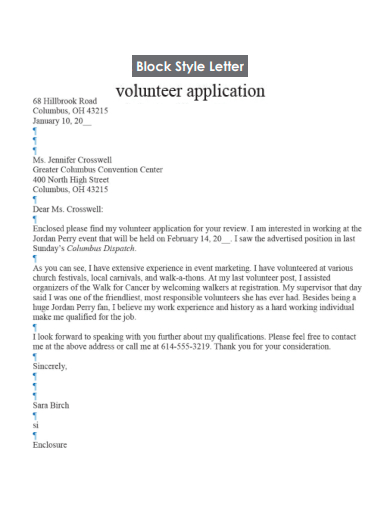
resources.iacademy.com
7. Semi Block Letter Format
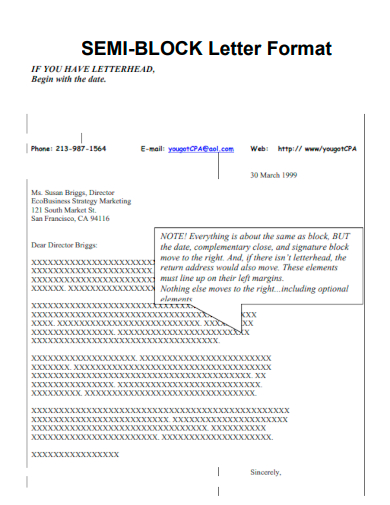
wikieducator.org
8. Sample Letter in Block Style Format
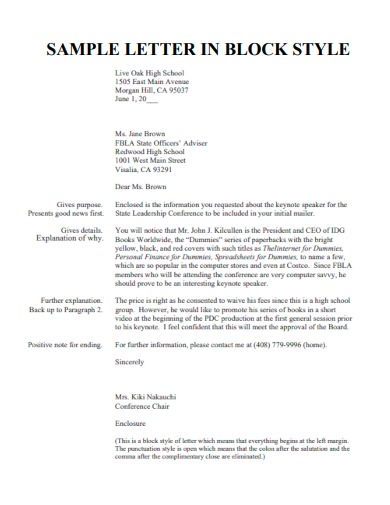
cafbla.org
9. Full Block Style Letter Format
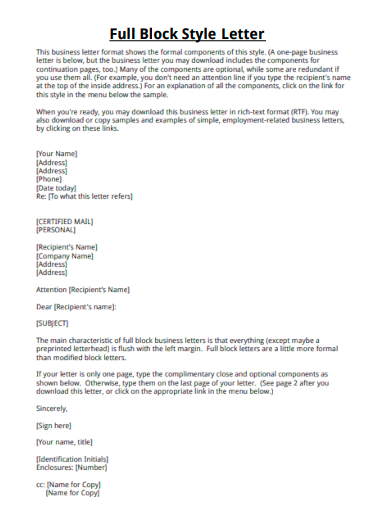
azureedge.net
10. Standard Block Letter Format

twc.edu.hk
11. Indented Block Letter Format
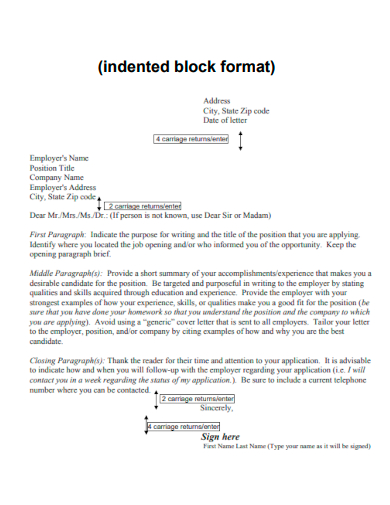
ee.hawaii.edu
12. Block Letter Assignment Format
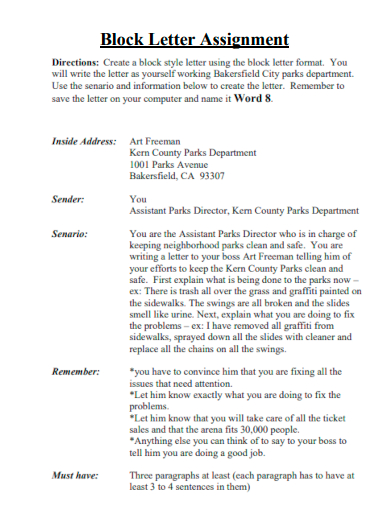
cdn.inst-fs-iad-prod
13. Modified Block Format Letter
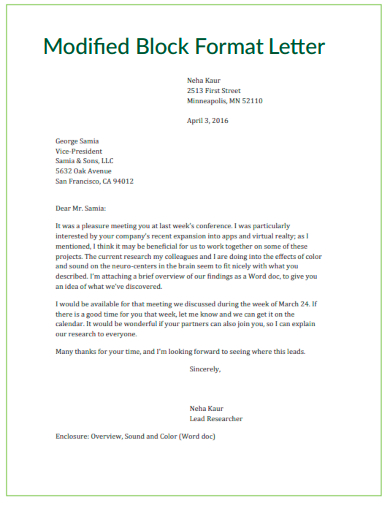
peregrine.ysn.com
14. Formal Block Letter Format
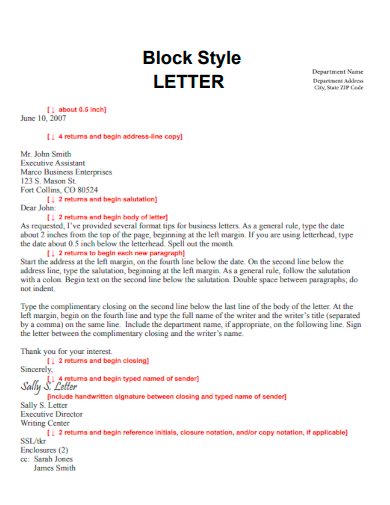
sd.us
15. Final Reflection Block Style Letter
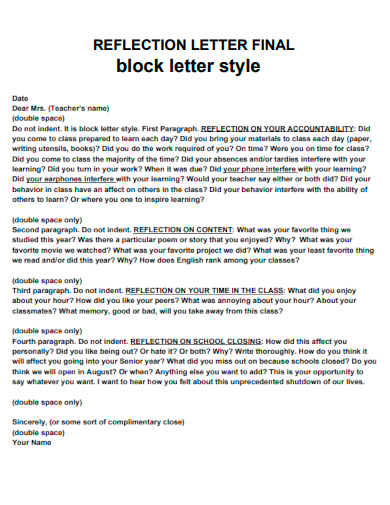
guthrieps.net
16. Simple Block Letter Format
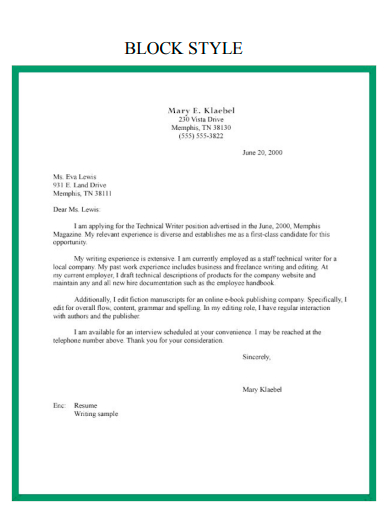
gyansanchay.csjmu.ac
17. Scholarship Committee Block Letter Format

18. Basketball Coach Block Format Letter
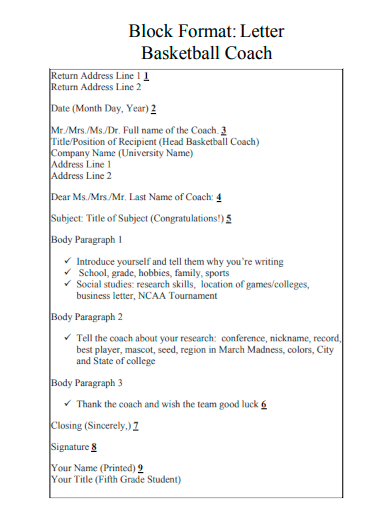
wpmucdn.com
19. Company Block Letter Format
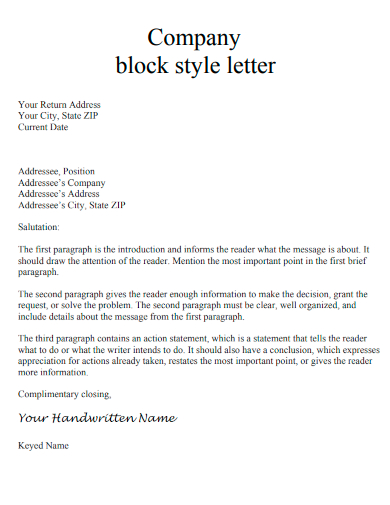
wsalem.wi.us
20. Assistant Professor Block Letter Format
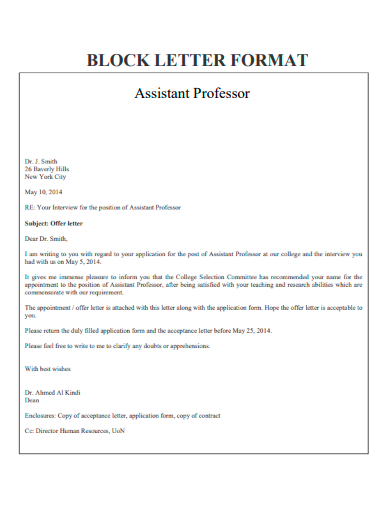
unizwa.edu
Uses of Block Letters in Professional Settings
Block letters, characterized by their clear and legible form, play a crucial role in various professional settings. This standardized writing style ensures that communication is straightforward and universally understandable, making it ideal for a wide range of applications. Here are some key uses of block letters in professional environments:
Business Correspondence: In business letters, memos, and emails, block letters contribute to the clarity and formality of the communication. They are particularly useful in ensuring that important information is easily readable, reducing the chance of misinterpretation.
Signage and Wayfinding: Block letters are extensively used in signage due to their high legibility at a distance. This includes office directories, safety signs, and informational signage, helping individuals navigate spaces efficiently and safely.
Legal Documents: The use of block letters in legal documents such as contracts, agreements, and official forms minimizes ambiguity. This clarity is essential in legal contexts, where precise language and readability are paramount.
Branding and Logo Design: In branding, block letters offer a clean, impactful aesthetic. They are often used in logos, business cards, and marketing materials to convey strength, reliability, and professionalism.
Technical Manuals and Reports: Technical documentation, such as manuals, reports, and specifications, benefits from the use of block letters. This style facilitates the comprehension of complex information, making it accessible to a broader audience.
Labeling and Packaging: Product labels and packaging often employ block letters to ensure that essential information, such as ingredients, usage instructions, and safety warnings, is easily legible.
Online Content Creation: For digital content, including websites, blogs, and social media posts, block letters enhance readability on various devices. This is crucial for engaging readers and conveying messages effectively in the digital age.
Educational Materials: In educational settings, block letters are used in textbooks, study guides, and visual aids to support learning. Their clarity helps students of all ages focus on the content without the distraction of deciphering handwriting.
Professional Presentations: Block letters are favored in PowerPoint presentations and informational handouts to ensure key points are readable, even from a distance. This enhances communication effectiveness in meetings, conferences, and workshops.
Record Keeping and Filing Systems: In administrative tasks, block letters improve the organization and retrieval of documents. This is especially useful in filing systems, where clear labeling helps in maintaining efficient records management.
FAQs
How to Do Block Letters for Kids
Teaching kids to write block letters involves starting with simple shapes, like squares and circles, to form letters. Use lined paper for guidance, showing them how to construct letters piece by piece. Practice regularly with large, clear examples and encourage creativity.
How to Do the Letter A in Block Letters
To draw the letter ‘A’ in block letters, start with two diagonal lines that meet at a point at the top. Add a horizontal line across the middle to complete the structure. Ensure the lines are straight and of equal thickness for uniformity.
What Is Block Letter Layout?
The block letter layout is a writing format where all text is aligned to the left margin, creating a clean and uniform appearance. This layout includes single spaces between lines and a double space between paragraphs, commonly used in formal business correspondence.
Why is Block Letter Format used?
Block Letter Format is used because it is clear and easy to read, and it gives a professional appearance to business letters.
Is Block Letter Format the only format for business letters?
No, there are other formats for business letters, such as Modified Block Format and Semi-Block Format. However, Block Letter Format is the most commonly used format.
Are there any variations to the Block Letter Format?
Yes, there can be slight variations to the Block Letter Format depending on the specific requirements of the letter or the preferences of the writer. However, the basic elements of the format, such as the alignment and spacing, should remain consistent from the title page, introduction paragraph, and down to the conclusion paragraph.
In conclusion, Block Letter Format is a widely used format for business letters that gives a professional and polished appearance to the letter. By following the steps outlined in this format, writers can ensure that their letters are easy to read and convey a clear and concise message. Whether for job applications, introductions, or recommendations, Block Letter Format is a reliable and effective choice for formal business letter correspondence.


